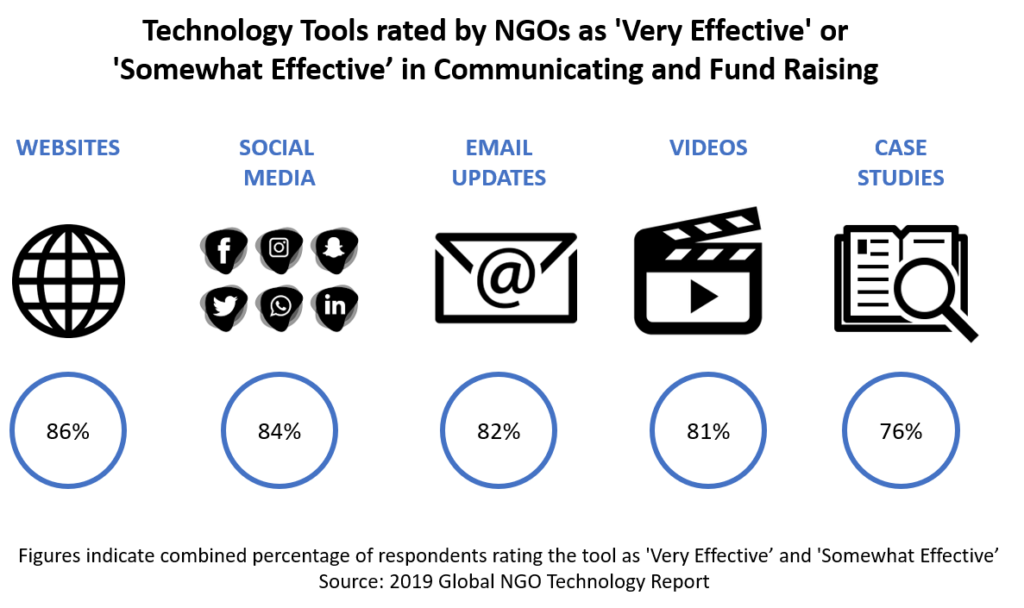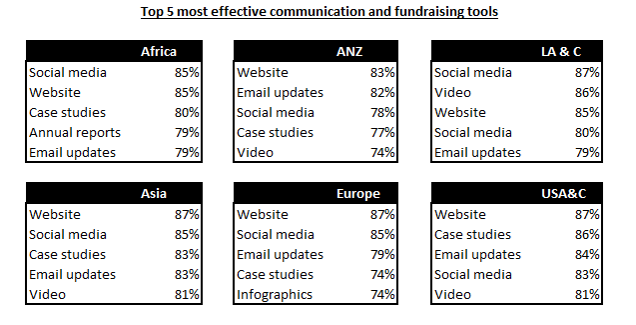
Marketing Technologies Used by Nonprofits
Marketing technologies used by Nonprofits get varying ratings in terms of effectiveness.
The 2019 Global NGO Technology Report provides excellent and voluminous data about how NGOs use and regard technology in communication and fundraising.
What makes especially interesting reading is the rating by NGOs of the effectiveness of various technology tools they use.
Globally five technology tools were rated the most ‘very effective’ or ‘somewhat effective’ in communicating and fund raising by NGOs. The five tools were Websites, ‘Social Media’, ‘Email Updates’, ‘Videos’ and ‘Case Studies’. The rating of these can be seen in the figure below.

Whats fascinating is that rating of the effectiveness of different tools does not depend on the level of technology. Websites and Social media received almost the same scores. Websites are a tool for communicating with inward-bound respondents, while social media is a shout-out. Similarly email updates, a mature technology considered a ‘legacy’ tool received similar scores to social media and videos – both technologies that emerged a generation after email. So we see that NGOs consider different technologies to have similar effectiveness.
What this implies for NGOs is the need to have communication and fund raising capabilities across a range of technologies of different vintages, and not just for the latest. This can also be advantageous since the cost for NGOs of using these more mature tools could be lower than that of their more technologically advanced corporate brethren. In this short post I wont get into how to define the choices for NGOs, but suffice to say it would depend on the strategic direction that each sets in terms of programs and donors.
Another interesting aspect the Report covers is how the effectiveness of technology tools varies between different regions. The Report categorizes the world into 5 regions – Africa, Asia, Australia & New Zealand (ANZ), Europe, Latin America & Caribbean (LAC), and USA & Canada (USAC). The assessment of the top 5 tools in each region can be viewed in the table below.

As can be seen, each region has a different assessment of the most effective communication and fundraising tools. For example, a Website is considered the most effective tool globally except in Latin America where Social Media AND video outscored it. Similarly while Social Media was the second most important across Africa, Asia, Europe and the most important in Latin America, in the ANZ region Email Updates were considered the second most important tool while in the USA/Canada region Case Studies were considered the second most important. In the Africa region, Annual Reports are, uniquely to this region, an important tool but absent from the top 5 elsewhere. Similarly, in Europe, Infographics are in the top 5 tools but are not as important in any other region.
NGOs operating across different regions will therefore need to adopt a localized communication mix strategy in each region. It also means that NGOs trying to quickly leverage lessons from other geographies to their particular country may not see the benefits they expect.
These, and other aspects of the Report, make it clear that NGOs must carefully develop an operating model with the right talent, structure and capabilities, to be able to effectively use technology in achieving their communication and fundraising objectives.
About the Author
Atul Vaid has extensive experience in strategic planning, market entry consulting and new initiatives development. He has 20+ years of consulting and corporate experience with global firms, where he has handled a variety of assignments in India, the Middle East, the USA and Japan; as well as cross-border engagements run remotely out of India. He has set up the marketing services hub for a US-based management consulting and technology firm, started an online skills assessment portal, and run a global innovation program for a strategy consulting firm. Atul is based in Gurgaon, outside of New Delhi in India and can be reached here.
This post originally appeared on Linkedin.
